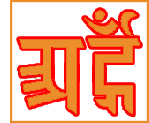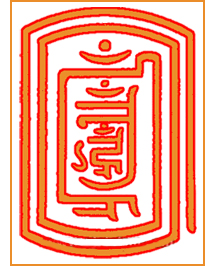Jain Sects
Jain Emblem
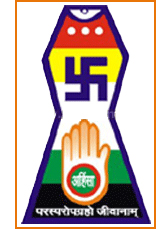 The Jain Emblem is a congregation of various symbols, each having a deeper meaning. In 1975 this symbol was adopted by all sects of Jainism while commemorating the 2500th anniversary of the nirvana of Lord Mahaveera.
The inner part of the Emblem contains Swastika (explained below) and Jain Hand (explained below).
The meaning of the mantra at the bottom (PARSPAROGRAHO JIVANAM) is "Live and Let Live". All creatures should help one another.
The Jain Emblem is a congregation of various symbols, each having a deeper meaning. In 1975 this symbol was adopted by all sects of Jainism while commemorating the 2500th anniversary of the nirvana of Lord Mahaveera.
The inner part of the Emblem contains Swastika (explained below) and Jain Hand (explained below).
The meaning of the mantra at the bottom (PARSPAROGRAHO JIVANAM) is "Live and Let Live". All creatures should help one another.
The outline of the symbol is defined as the universe. It consists of three realms (Loks). The upper portion indicates URDHAVA LOK (heaven). It contains the heavenly abodes (Devloka) of all the celestial beings and abode of the Siddhas (Siddhashila). The middle portion indicates MADHYALOK (material world). It contains the Earth and other planets (Manushyalok). And the lower portion indicates ADHOLOK (hell). It contains the seven hells (Naraka). Jainism says that this universe was neither created by anyone, nor can it be destroyed by anyone. It may change its form, but otherwise, it has always been and will always be here.

The overall symbol depicts the belief that living beings of all the three worlds (heaven, hell, and earth) suffer from the miseries of transmigratory existence. They can follow the path of true religion, which is Right Faith, Right Knowledge, and Right Conduct as expounded by the Tirthankars. This will bring auspiciousness to themselves, minimize suffering to others, and help them to obtain perfection, after which they will live forever as perfected beings. In short, the Jain emblem represents many important concepts to show the path to enlightenment by following the basic principles of AHIMSA (non-violence), TRIRATNA (right belief, right knowledge, and right conduct) and helping others. The JAINA symbol replaces swastika with OM because Swastika is not viewed as a pious religious symbol by the western world.
Swastik
 It is a symbol of the seventh Jina (Saint), the Tirthankara Suparsva. It consist of two parts. One part includes the Red and Blue part of the image. All other religions believe in this part only. But swastik in jainism includes 3 dots and a crescent moon with a dot also.
It is a symbol of the seventh Jina (Saint), the Tirthankara Suparsva. It consist of two parts. One part includes the Red and Blue part of the image. All other religions believe in this part only. But swastik in jainism includes 3 dots and a crescent moon with a dot also.
Four arms of SWASTIKA symbolizes the four GATI (destiny) of worldly souls (non-liberated): NARAKVASI (hellish beings), TRIYANCH (animals, birds, plants), MANUSHYA (humans) and DEV (heavenly beings). It represents the perpetual nature of the universe in the MADHYALOK (material world), where a creature is destined to one of those states based on their Karmas (deeds). It reminds us that worldly souls undergo a continuous cycle of birth, suffering, and death in these four forms. Hence one should follow the true religion and be liberated from suffering. It also represents the four columns of the Jain Sangh (community): Sadhus, Sadhvis, Shravaks and Shravikas - monks, nuns, female and male laymen. It also represents the four characteristics of the soul: infinite knowledge (Anant Gyan), infinite perception (Anant Darshan), infinite happiness (Anant Sukh), and infinite energy (Anant Virya).
The green dots represent the Triratna (Jain Trinity: three jewels of jainism): Samyak Darshan (Right Faith), Samyak Gyan (Right Knowledge) and Samyak Charitra (Right Conduct) which together lead to liberation. This gives the message that it is necessary to have TRIRATNA in order to attain MOKSHA. The Crescent moon and the dot i.e. the yellow part of the image represents the abode of the liberated souls (Siddha - Loka or Siddhashila or Moksha) which is a zone beyond the three realms (loks). All of the Siddhas (liberated bodyless souls) reside on this forever, liberated from the cycle of life and death.
In the Svetambar Jain tradition, it is also one of the symbols of the ashta-mangalas. It is considered to be one of the 24 auspicious marks and the emblem of the seventh arhat of the present age. All Jain temples and holy books must contain the swastika and ceremonies typically begin and end with creating a swastika mark several times with rice around the altar.
Jain Hand
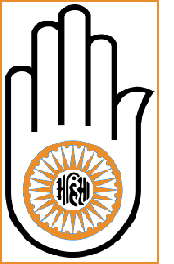 The palm of the hand signifies the assurance; 'do not be afraid', indicating that human beings suffering due to karmic bondage do not need to be disheartened. Another meaining is “stop and think before you act to assure that all possible violence is avoided.” This gives us a chance to scrutinize our activities to be sure that they will not hurt anyone by our words, thoughts, or actions. We are also not supposed to ask or encourage others to take part in any harmful activity.
The palm of the hand signifies the assurance; 'do not be afraid', indicating that human beings suffering due to karmic bondage do not need to be disheartened. Another meaining is “stop and think before you act to assure that all possible violence is avoided.” This gives us a chance to scrutinize our activities to be sure that they will not hurt anyone by our words, thoughts, or actions. We are also not supposed to ask or encourage others to take part in any harmful activity.
The wheel in the hand symbolizes SAMASARA (reincarnation cycle). It shows that if we are not careful and ignore these warnings and carry on violent activities, then just as the wheel goes round and round, we will go round and round through the cycles of birth and death.
The word in the center of the wheel is "Ahimsa" (non-violence). Ahimsa means avoidance of Himsa (violence). It has been treated as the first of the five Mahavratas (great vows), prescribed by Jain religion and this Ahimsa Mahavrata has been defined in `Ratnakaranda-sravakachara' as "abstaining from the commission of five sins, himsa and the rest in their three forms, krita, karita and anumodana, with the mind, speech and the body constitutes the Maha-vrata of great ascetics".
The 24 spokes represents the preaching from the 24 Tirthankars (enlightened souls), which can be used to liberate a soul from the cycle or reincarnation.
Aum
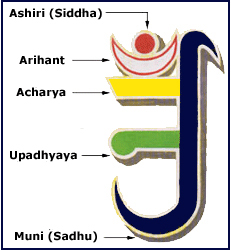 In Jainism, Aum is regarded to be a condensed form of reference to the five parameshthis, by their initials A+A+A+U+M (o3m). The Dravyasamgrah quotes a Prakrit line:
In Jainism, Aum is regarded to be a condensed form of reference to the five parameshthis, by their initials A+A+A+U+M (o3m). The Dravyasamgrah quotes a Prakrit line:
ओम एकाक्षर पञ्चपरमेष्ठिनामादिपम् तत्कथमिति चेत "अरिहंता असरीरा आयरिया तह उवज्झाया मुणियां
"oma ekākṣara pañca-parameṣṭhi-nāmā-dipam tatkabhamiti ceta "arihatā asarīrā āyariyā taha uvajjhāyā muṇiyā"
"Aum" is one syllable made from the initials of the five parameshthis. It has been said: "Arihanta, Ashiri, Acharya, Upadhyaya, Muni".
In Short, 'a' + 'a' + 'ā' + 'u' + 'm' = aum
a = Arihanta
a = Asrira (Siddha)
ā = Acharya
u = Upadhyaya
m = Muni (Sadhu)
Thus, ओं नमः (om namah) is a short form of the Navkar Mantra.
Jain Flag
 The Jains flag have five different colors.
The Jains flag have five different colors.
- Red color represents Siddha
- Yellow color represents Acharya
- White color represents Arihanta
- Green color represents Upadhyaya
- Dark Blue (or Black) color represents Muni (Sadhu)
There is a symbol of swastik in the central strip.
Other Symbols
Ashtamangala
Swastika
Swastika an auspicious symbol also known as sathia. It is customary to draw the swastika at the beginning of all religious ceremonies. |
 |
Shri Vatsa
Shri Vatsa an auspicious symbol on the upper chest of all 24 Tirthankaras showing compassionate universal eternal love for all living beings however minute they may be. |
 |
Nandavarta
Nandavarta a sacred complex form of swastika which is a visual icon for higher meditative attainment, a beautiful configuration formed by nine angles or corners of divinity. |
 |
Vardhamanaka
Varshamanaka an earthen bowl sealed with another earthen bowl and used as a lamp. This pair in Sanskrit is known as samput. The lit lamp is symbolic of light banishing darkness. |
 |
Bhadrasana
Bhadrasana a holy seat, the royal throne. Also regarded as the sacred seat for the liberated souls, this is a seat of honor for evolved souls. |
 |
Kalasha
Kalasha the holy pitcher with two divine eyes as well as two ends of a scarf drawn on either sides. This plays a prominent role in every auspicious ceremony. |
 |
Meen Yugala
Meen Yugula the fish couple. The form of the fish is considered divine, as it also shows the flow of divine life in the cosmic ocean. |
 |
Darpana
Darpana symbolises true self. True self is our own soul. |
 |
Hrim
It is a seed mantra. It represents invisible sound, infinity and divine energy of all tirthankars. While meditating HRIM one experiences sublimating of 24 Tirthankars.
Arham
The ARHAM mantra is pregnant with the vowels and consonants of Sanskrit language.A is the first alphabet and H is the last alphabet of Sanskrit language. In this Mantra sound of all vowels and all consonants are present.
Om Hrim Arham
The ARHAM mantra is pregnant with the vowels and consonants of Sanskrit language.A is the first alphabet and H is the last alphabet of Sanskrit language. In this Mantra sound of all vowels and all consonants are present.








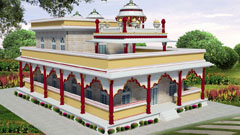
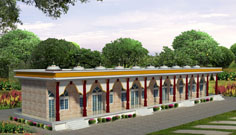















 The Jain Emblem is a congregation of various symbols, each having a deeper meaning. In 1975 this symbol was adopted by all sects of Jainism while commemorating the 2500th anniversary of the nirvana of Lord Mahaveera.
The inner part of the Emblem contains Swastika (explained below) and Jain Hand (explained below).
The meaning of the mantra at the bottom (PARSPAROGRAHO JIVANAM) is "Live and Let Live". All creatures should help one another.
The Jain Emblem is a congregation of various symbols, each having a deeper meaning. In 1975 this symbol was adopted by all sects of Jainism while commemorating the 2500th anniversary of the nirvana of Lord Mahaveera.
The inner part of the Emblem contains Swastika (explained below) and Jain Hand (explained below).
The meaning of the mantra at the bottom (PARSPAROGRAHO JIVANAM) is "Live and Let Live". All creatures should help one another. It is a symbol of the seventh Jina (Saint), the Tirthankara Suparsva. It consist of two parts. One part includes the Red and Blue part of the image. All other religions believe in this part only. But swastik in jainism includes 3 dots and a crescent moon with a dot also.
It is a symbol of the seventh Jina (Saint), the Tirthankara Suparsva. It consist of two parts. One part includes the Red and Blue part of the image. All other religions believe in this part only. But swastik in jainism includes 3 dots and a crescent moon with a dot also. The palm of the hand signifies the assurance; 'do not be afraid', indicating that human beings suffering due to karmic bondage do not need to be disheartened. Another meaining is “stop and think before you act to assure that all possible violence is avoided.” This gives us a chance to scrutinize our activities to be sure that they will not hurt anyone by our words, thoughts, or actions. We are also not supposed to ask or encourage others to take part in any harmful activity.
The palm of the hand signifies the assurance; 'do not be afraid', indicating that human beings suffering due to karmic bondage do not need to be disheartened. Another meaining is “stop and think before you act to assure that all possible violence is avoided.” This gives us a chance to scrutinize our activities to be sure that they will not hurt anyone by our words, thoughts, or actions. We are also not supposed to ask or encourage others to take part in any harmful activity. In Jainism, Aum is regarded to be a condensed form of reference to the five parameshthis, by their initials A+A+A+U+M (o3m). The Dravyasamgrah quotes a Prakrit line:
In Jainism, Aum is regarded to be a condensed form of reference to the five parameshthis, by their initials A+A+A+U+M (o3m). The Dravyasamgrah quotes a Prakrit line: The Jains flag have five different colors.
The Jains flag have five different colors.








